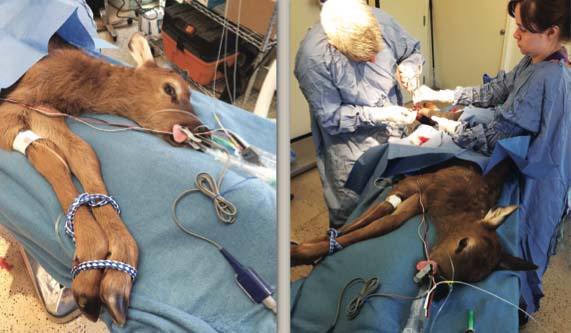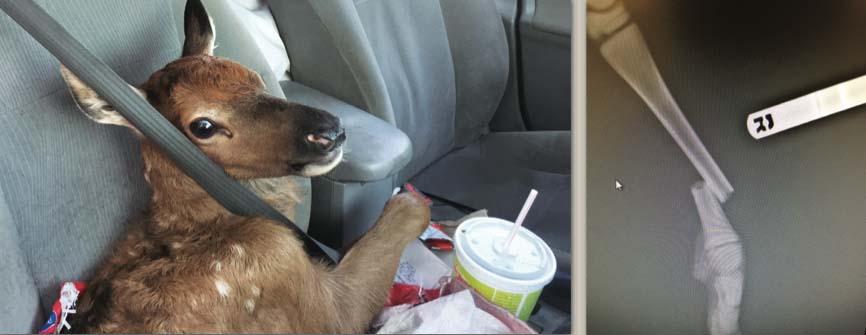Elk Calf
A family that had been camping called to say they had found a deer fawn with a broken hind leg and were on their way to SWCC with it. When they arrived, staff was shocked to see an elk calf sitting in the front seat—wearing a seat belt!—and two toddlers sitting in their car seats in the back.

They explained that they had been camping and first saw the mother and calf shortly after he was born, still wet with amniotic fluid. The family knew not to disturb them, so they only watched from afar. However, after the third day the calf still could not stand to nurse.
The next day, its mother left him to return to the herd, leaving him alone. He tried valiantly, but unsuccessfully, to get up and cried for his mother all night long. When the family broke down their campsite and loaded the kids up, they said they just couldn’t leave him there to die a slow death from dehydration and starvation or to be killed by a predator.
A SWCC vet-tech took X-rays and called in a surgeon to repair the leg. During surgery, a plate was attached to his leg so it would heal completely and correctly.

Arizona Game & Fish Department prohibits the release of rehabbed deer and elk back into the wild because of the possibility they could be carriers of chronic wasting disease, which can decimate entire herds. The calf could not go back into the wild, but he could be placed in a zoo. The Navajo Nation Zoo was in need of another elk, so arrangements were made to transfer him to live with them. He’s now living there and enjoying a very large enclosure and the companionship of another elk.
Coyote Pup in Bumper
Our local fire department called asking for our help when a woman drove into the station with a coyote pup caught on her bumper. She had hit the pup when it attempted to cross the road right in front of her car, and its hind legs were wedged in the bumper. Not knowing what to do, she kept driving until she got to the fire station.

The firemen were shocked at what they saw and not quite sure how to extricate the pup. However, by using a little ingenuity, they had freed the pup by the time SWCC volunteer rescuers arrived. She was lying on the ground, exhausted and bleeding. Our volunteer wrapped the pup in a blanket and transported her to SWCC.
She was about 8 months old, exhausted, and in shock. She was given fluids, antibiotics, and pain meds and placed on a specialized heating pad to warm her. Part of her lip was missing, her tongue was burned, and her front paws were bloody and had sustained deep wounds from being dragged on the asphalt. She was x-rayed and, amazingly, had no broken bones!
She was sedated so her legs could be cleaned and bandaged. After a couple of days, she finally started to eat and her lips and tongue have completely healed. However, she will stay at SWCC for some time while her legs continue to heal, after which she will be released back into the wild.
Babies, Babies, and More Babies
This year, even while fighting to save SWCC from being closed down, we helped more animals than ever before. So, it should come as no surprise that it was also a record year for orphans at SWCC! Every day during orphan season there were new arrivals: tiny orphaned bobcat kittens, javelina babies, raccoon kits, coyote puppies, and baby skunks. Most heart rending were the multiple dis- placed and frightened mother bobcats who defensively cuddled their newborn kittens beneath them.

Regardless of all that was going on with respect to our legal drama, we had to focus on the animals and be there for them no mat- ter what. Formula had to be mixed, babies fed, bandages changed, and medication given. There were lots and lots of cages to be cleaned, laundry to do, and dishes to wash.
Staff and volunteers were exhausted; they worked all day and then fed neonatal babies throughout the night—only to start all over again the next day! They soldiered on despite their exhaustion, knowing how important it was that the babies were warm and had full bellies. Once the little ones are eating on their own, they are handed over to our four-legged staff—our foster parents—to continue the rehab process and prepare for their eventual release back into the wild.
The work at SWCC is never easy, but it is rewarding. It is also expensive. In spite of this, we are determined to be here for wildlife in need today, tomorrow, and into the future. The publicity from the lawsuit and zoning issue has greatly increased public awareness of SWCC, which has benefitted so many more wild animals than SWCC has ever been able to help before. While this is good for wildlife, it also means SWCC staff and volunteers are working harder than ever to help give these animals another chance.
We will continue our hard work, but cannot provide our life-saving efforts without your support. Please make your donation today. The animals that benefit from our Center may not be able to express their gratitude, but I can: Thank you for helping us to survive the challenges we faced this year and thank you for your unwavering support of our mission!





